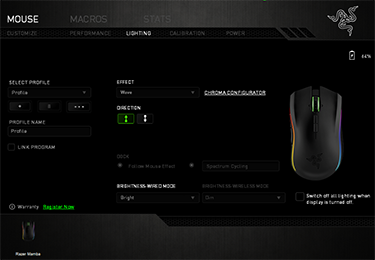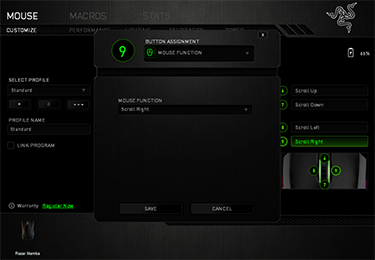Software, usage and conclusion
There are no surprises with the Synapse software shipping with Razer products. It is split into three logical tabs - mouse, macros and stats. The mouse tab includes the majority of the tweaking options such as acceleration, button assignments, DPI adjustments, lighting effects and surface calibration, and this is where gamers can fine-tune the mouse to their liking.
Configurability is a strong point of the software, as is the simple, intuitive way it is laid out, but we still don't like fact that the configured options are stored in the cloud, not on any memory resident on the mouse itself. Razer will argue that a cloud-based approach enables the user to download their preferred settings to any machine in one fell swoop, yet we question the number of times a single product will be moved between devices. Being fair, the cloud approach does have some merit if you own multiple Razer devices, where settings are automatically downloaded and applied.
Back to the software, the lighting tab usefully splits off adjustments into two separate layouts. The primary window allows users to pick between preset effects as well as choose the direction of flow and the brightness level. A second, more advanced layout can be entered by clicking through to the Chroma Configurator which allows for individual customisation of each of the 16 LEDs depending on the mode in question.
In use we found no perceivable difference between using the Mamba in the preferred wireless or corded modes. Tracking was precise and lag-free in both instances. The Philips' sensor has a lift-off distance of just 0.1mm after which it stops tracking, meaning that repositioning movements across the mousepad don't interfere with tracking that headshot if you happen to be a 'lifter'.
The 16,000 DPI figure is more useful for bombastic marketing than real-world gaming. Having a play at that setting on a 4K monitor reveals that mouse movements are too fast for the regular gamer, while most pro gamers won't play at such a graphically intense setting anyway. If nothing else, the Mamba's sensor is primed for gamers who don't want to worry about smoothly sailing across super-high-resolution screens for years to come.
The Mamba's 125g weight makes it feel quite light in our opinion. The lack of mass, compared to other gaming mice, is certainly noticeable with quick movements and constant repositioning in fast-paced games. Some like this, others don't, and we'd recommend a weighting system often in evidence elsewhere.
Very minor niggles don't take away from the notion that this is a well-thought-out mouse. Excellent design, solid build quality, and lag- and wire-free gaming are augmented with a comprehensive roster of options available from the Synapse software.
Excellence in almost all facets that matter to the gamer, the Razer Mamba 2015 mouse is a high-quality product. Such praise is tempered by the £135 retail price that puts it out the reach of many gamers. If you can justify it, there are few peripherals that are better. For everyone else, the corded Mamba Tournament Edition, costing £55 less, is certainly the more viable option.

|
The Good
|
The Bad
|
|
|
Stylish RGB lighting |
Premium pricing |
HEXUS awards

Razer Mamba (2015)
HEXUS where2buy
The Razer Mamba (2015) mouse is available from Scan Computers*.
HEXUS right2reply
At HEXUS, we invite the companies whose products we test to comment on our articles. If any company representatives for the products reviewed choose to respond, we'll publish their commentary here verbatim.
*UK-based HEXUS community members are eligible for free delivery and priority customer service through theSCAN.care@HEXUS forum.

















